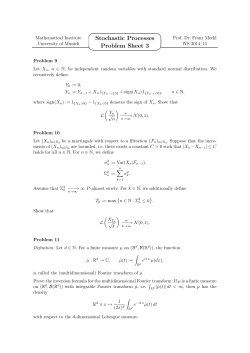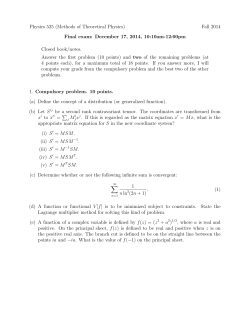
Key_P1 - Weber State University
1 EE 2260 Fundamentals of Electric Circuits Final Exam (Key) Topics: Fourier Series, Fourier Transform, Bode Plots, Filters Instructions: 1) ALWAYS SHOW YOUR WORK! 2) Put a box or circle around your answers. 4) Open Notes, Open Book, Closed Multisim/LTSpice, Closed Internet. Any type of calculator is allowed. It’s ok to write on the book pages and the test. Restroom break is allowed. 5) Numbers in the square brackets indicate points. Name: _____________Suketu Naik__________________________ Date: ___4/23/15____________ Problem Points 1. Concepts /25 2. Fourier Series /25 3. Fourier Transform /25 4. Filters /25 Total Weber State University EE2260 Fundamentals of Electric Circuits /100 Suketu Naik 2 1. Concepts [25] 1. Match each of the waveforms to its Fourier Series. [8] Hint: determine whether its an odd or even function before matching. Definition: f (t ) av (an cos n0t bn sin n0t ) n 1 f1 (t ) av (an cos n0t bn sin n0t ) n 1 f 2 (t ) an cos n0t n 1 f 3 (t ) av bn sin n0t n 1 f 4 (t ) bn sin n0t n 1 2. Identify the type of filters shown below [8]. LPF High Pass Bandpass All pass 3. What does the linear phase in the Bode plot of a given filter indicate [4]? Phase indicates how much the output signal will be delayed in comparison with the input signal. Hence phase is associated with time-delay (time delay t=phase ϕ/(360*frequency f)). Linear phase indicates that there is going to be same time delay for all the frequencies, since t will be the same. This allows for all the harmonics to be delayed by the same amount 360 f which is important for processing an input signal with multiple frequencies (e.g. Audio signal which contains many harmonics can be clear otherwise it will be distorted) so that it won’t be distorted at the output. 4. When should we use an active filter instead of a passive filter [5]? Active filters use op-amp which can provide low frequency gain and hence shift the entire response up to a certain gain value. Op amps also help stabilize the filter against any abrupt change in temperature or spikes (To an extent) by adjusting its current while being used in the feedback configuration. Weber State University EE2260 Fundamentals of Electric Circuits Suketu Naik 3 2. Fourier Series [25] The periodic square-wave voltage with Vm = 30π V and T = π ms is applied to the circuit shown below. (a) Convert the circuit into the S-circuit and derive the transfer function. [10] (b) Find the first three nonzero terms of Fourier series (trigonometric form) that represents the output voltage vo. [15] Weber State University EE2260 Fundamentals of Electric Circuits Suketu Naik 4 Weber State University EE2260 Fundamentals of Electric Circuits Suketu Naik 5 3. Fourier Transform [25] Consider the circuit shown below. There are no initial currents or voltages in the circuit. Here, vi (t) = 10e-5t , R=65 Ω, and C= 1 μF. (a) Convert the circuit into S-domain circuit and derive the transfer function. [10] (b) Using the Fourier Transform Method, derive expression for the voltage vo(t).[15] Hint: it’s best to work with Laplace transform and then convert it into Fourier transform. Weber State University EE2260 Fundamentals of Electric Circuits Suketu Naik 6 Weber State University EE2260 Fundamentals of Electric Circuits Suketu Naik 7 4. Filters [25] (a) Design the first order passive high pass filter below. Assume C =1 μF. Find the value of R if the cutoff frequency, fc = 2.45 kHz. [10] (b) Design the first order active high pass filter below. Assume that C=1 μF, passband gain K=10. Find the value of R1 and R2 if the cutoff frequency, fc = 2.45 kHz. [10] (c) What would happen to the frequency response of the filter shown in (b) if you were to replace the capacitor with an inductor? [5] Weber State University EE2260 Fundamentals of Electric Circuits Suketu Naik
© Copyright 2025










